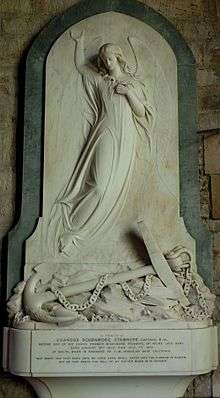Chandos Scudamore Scudamore Stanhope
| Chandos Scudamore Scudamore Stanhope | |
|---|---|
 Chandos S. Stanhope memorial | |
| Born |
January 19, 1823 Holme Lacy, England |
| Died |
July 7, 1871 (aged 48) Malta |
| Allegiance | British |
| Service/ | Royal Navy |
| Rank | Captain |
| Commands held | HMS Ocean, Caledonia |
| Awards | Royal Humane Society Silver Medal |
| Relations | Sir Edwyn Francis Scudamore Stanhope, Mary Dowel, Philip Stanhope, 1st Earl of Chesterfield |
Chandos Scudamore Scudamore Stanhope (also Chandos S. Stanhope; 19 January 1823 – 7 July 1871) was a British Royal Navy officer of the nineteenth century. He is recognized as a national hero, and a unique medal and award was named in his honour.
Early life
Born in Holme Lacy, England, on 19 January 1823, Stanhope was the second son of Sir Edwyn Francis Scudamore Stanhope and Mary Dowell (died after 1859). He was the grandson of Philip Stanhope, 1st Earl of Chesterfield. Stanhope's older brother was Henry Scudamore-Stanhope, 9th Earl of Chesterfield. His other siblings were Berkeley Lionel Scudamore-Stanhope (1824 – post 1861); Edwyn Francis Brydges Scudamore-Stanhope (1826–1855); William Pitt Scudamore-Stanhope (b. 1827); Anna Eliza Scudamore-Stanhope (1829–1830); Arthur Chesterfield Scudamore-Stanhope (1833–1841); and Philip John Scudamore-Stanhope (b. 1839).[1][2][3][4]
Mid-life and career
Stanhope served as a naval officer mate from November 1842 after he passed his officer's exam. He was promoted to the rank of lieutenant in March 1846. He was also a personal assistant to First Lord of the Admiralty Hugh Childers for nine months.[5]
Stanhope served on HMS Warspite, a 50-gun ship with captains Sir John Hay and Sir Provo William Parry Wallis. These ships served the North America, West Indies, and Mediterranean ports. He was appointed in December 1846 to HMS Queen, a 110-gun ship of Sir John West at Devonport. Stanhope later served from August 1847 in the Pacific on HMS Asia, a 84-gun ship commanded by Rear-Admiral Phipps Hornby.[4] Stanhope became a Captain in October 1858.[5] He commanded the ship HMS Ocean from Rio de Janeiro to Singapore in 1867. The trip started on August 10[6] and it arrived on October 23, 1867.[7]
Death and legacy
Stanhope died of smallpox in Malta on 7 July 1871. At the time he was in command of the ironclad ship Caledonia.[8] He was recognized as a hero in his lifetime, as he was ready to risk his life to help others.[9][10] He received a Royal Humane Society Silver Medal in 1851 for a life-saving rescue of a seaman. Soon after his death a group of his friends formed a memorial in his honour and raised a large sum of money.[9] They gave the money to the Royal Humane Society on the terms that any interest the money earned would be for a periodic gold medal to be given for the greatest gallantry of a hero of the previous year.[9] It is called the "Stanhope Medal" or "Stanhope Gold Medal" to honour him.[9]
References
- ↑ Laurie, Ben (2007). "Chandos Scudamore Scudamore-Stanhope (1823–1871)". Family: Scudamore-Stanhope. Genealogy Links. Retrieved July 3, 2016.
- ↑ "Personal". The Morning News. Wilmington, Delaware. January 22, 1887.
- ↑ "Death of Earl of Chesterfield". The Morning News. Belfast, Ireland. October 22, 1883.
- 1 2 O’Byrne 2012, p. 1108.
- 1 2 Davis, Peter (2016). "Biography of Chandos Scudamore Scudamore Stanhope R.N." HMS Surprise. Peter Davis. Retrieved July 1, 2016.
- ↑ "An Ironclad In A Cyclone (second part, column six)". Sydney Morning Herald. New South Wales, Australia. February 21, 1868.
- ↑ United Service Gazette (February 21, 1868). "An Ironclad In A Cyclone". Sydney Morning Herald. New South Wales, Australia.
- ↑ Winfield 2014, p. 395.
- 1 2 3 4 "The History of the Stanhope Medal". Royal Humane Society. Retrieved July 1, 2016.
It seems he may have saved other lives, too. His obituary in The Times (19 July 1871) recalled that "on several occasions he showed readiness to risk his own life for others." He died from smallpox in 1871, at the age of 48. A group of his closest friends set up a memorial fund and raised several hundred pounds. His friends decided to give the money raised to the Royal Humane Society on condition it would "agree to give annually a gold-medal for the case of the greatest gallantry during the year, to be called the "Stanhope Medal".
- ↑ "Military and Naval Intelligence". The Times. London, England. July 19, 1871.
Sources
- *O’Byrne, William R. (6 February 2012). A Naval Biographical Dictionary – Volume 3. Luton: Andrews UK Limited. ISBN 978-1-78150-281-5.
- Winfield, Rif (30 April 2014). British warships in the age of sail 1817–1863: design, construction, careers and fates. South Yorkshire, England: Seaforth Publishing. ISBN 978-1-4738-4962-4.